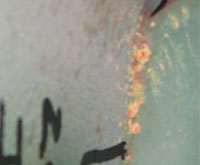 AP/Wideworld |
 AP/Wideworld |
 Tudor van Hampton Rosenker (bottom) leads NTSB investigation into the bridge failure. Portions of the bridge were accessible to rescuers and investigators but turbulent water hindered some efforts. |
...slab approach spans and steel deck truss main spans. It was constructed with a single 458-ft-long steel arch to avoid putting piers into the water that would obstruct river traffic. Its design has been criticized by bridge engineers because of a lack of redundancy.
Failure Sequence
After reviewing the video, which Rosenker likens to an aircraft flight recorder, NTSB's metallurgists and engineers began turning their attention to the south abutment. The cantilevered truss at that end fell about 81 ft from its normal position, while the rest of the bridge fell straight down. The bridge's 9-in.-thick concrete deck, which spanned across eight lanes of traffic, peeled away from the truss laterally and fell to the east of its original position. The truss fell to the west. After about a day of examination, NTSB found the shift to be a secondary action. "We found no defects…that may have been causal to the accident," Rosenker says.
The feds turned their attention to the other side of the bridge, where twisted steel and razor-sharp rebar sticking into the air made access treacherous. After completing total station surveys and laser scans of the wreckage using equipment supplied by the FBI, forensic engineers flew a helicopter fitted with a high-resolution, remote camera to take up-close shots of the steel connections.
Rosenker says objects of interest will be clipped off, partially reconstructed on the ground and taken back to Washington, D.C., for laboratory analysis. If the team finds nothing there, the central section will be the next target for scrutiny. Investigators are going line by line through reams of records of the bridge, which carried 140,000 vehicles daily and was one of the busiest in the state.
Designed for a 50-year life span, I-35W was due to be replaced in 2020. Load tests indicated that the 40-year-old bridge might have performed better than designed, according to one engineering report. Records show that state engineers made a series of deliberate decisions to examine fatigue, repair aging connections and defer important retrofits to the bridge's fracture-critical deck truss.
How the state, which owns the bridge, went about inspecting, repairing and retrofitting the bridge and why is under investigation. So far, the state has vigorously defended its actions.
"Was there any malice or ill-intention? The answer is no," says Lt. Gov. Carol Molnau, also MNDOT's commissioner. The state's staff finds the accident "doubly baffling" because it took precautions it deemed necessary to care for the bridge, even exceeding federal guidelines by inspecting it every year instead of every two years as is typically prescribed.
The bridge has a long paper trail. In 1990, MNDOT rated it "structurally deficient" and "functionally obsolete" and gave the superstructure four out of nine points, or a "poor" rating. But no cracks were found in the main truss, so the structure was deemed safe for normal traffic loads. The state recommended further investigation of fatigue to define future repairs, and, if necessary, replacement.
Designed by Sverdrup & Parcel and built by Hurcon Inc. and Industrial Construction Co., the structure cost $5.3 million. It developed several problems that plagued MNDOT for nearly two decades. Mist from nearby St. Anthony Falls and bird droppings accelerated corrosion. A bearing froze, requiring jacking up the truss in 1986 to make repairs.
Over the past two decades, the state also drilled out numerous fatigue cracks, repainted the bridge, added steel stiffeners and installed a $618,000 potassium-acetate deicing system, the largest of its kind in the U.S. at the time with a 3,100-gallon tank and 76 spray nozzles in strategic locations on the bridge.
 Minnesota Dept. of Transportation Deteriorated welds were found in reports. |
Every study, including a University of Minnesota report in March 2001 that used strain gauges and finite-element analysis, found a bridge that was aging but still fit for service. "Since the measured and calculated stress ranges were less than the fatigue threshold…fatigue cracking is not expected in the deck truss of the bridge," says the report. It did note "many poor fatigue details" on the main and floor trusses, however.
Apparently, that's where engineers decided to prioritize repairs. The authors recommended inspecting 12 members of the main truss every two years, especially at the ends of the "clips" on the diaphragms and at "intermittent" fillet welds. They also advised MNDOT to visually inspect the ends of the "fin" attachments reinforcing splice welds on the lower chords and diagonals of the floor trusses every six months. The 2001 report concluded that the agency "does not need to prematurely replace this bridge because of fatigue cracking, avoiding the high cost associated with such a large project."
MNDOT continued yearly inspections, making repairs as necessary. It hired San Francisco-based URS Corp. in 2003 to begin a long-term evaluation of whether the fracture-critical bridge would collapse if any truss member failed, as predicted in the original design. Truss schemes of the bridge's era, though not as...

Post a comment to this article
Report Abusive Comment